Category
Popular Articles
- AI (12)
- Android (38)
- App Suggest (4)
- Apple (15)
- Apple TV (2)
- Bluetooth (3)
- Cars (2)
- ChatGpt (1)
- Chrome (2)
- Did you know? (1)
- E-Commerce News (1)
- Ecommerce Websites business (7)
- Electronics Shopping (5)
- Fashion Tips (3)
- Gaming (4)
- Google Gemini (3)
- Hair Care Tips (2)
- How to (13)
- iCloud (1)
- Infotainment System (1)
- Iphone (101)
- Job Posting (1)
- Lifestyle (3)
- Mac (20)
- Mobile Games (1)
- Netflix (1)
- Online Shopping Websites (2)
- Personal Finance Management (3)
- Product Reviews (3)
- Roku TV (4)
- Samsung (9)
- Shopping Tips (10)
- Spotify (1)
- Tech (92)
- Windows 11 (18)
- Zero Waste (3)
Discounted Products
-
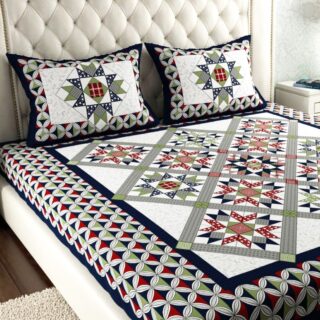 Leo Creation 144 TC Cotton Double Jaipuri Prints Flat Bedsheet(Pack of 1, Blue, Gree, Red, Grey, Light Grey)
Leo Creation 144 TC Cotton Double Jaipuri Prints Flat Bedsheet(Pack of 1, Blue, Gree, Red, Grey, Light Grey)
₹2,999.00Original price was: ₹2,999.00.₹329.00Current price is: ₹329.00. -
 Home Garage 210 TC Cotton King Floral Fitted (Elastic) Bedsheet(Pack of 1, Grey)
Home Garage 210 TC Cotton King Floral Fitted (Elastic) Bedsheet(Pack of 1, Grey)
₹999.00Original price was: ₹999.00.₹299.00Current price is: ₹299.00. -
 Goodrik 140 TC Cotton Double 3D Printed Flat Bedsheet(Pack of 1, Brown)
Goodrik 140 TC Cotton Double 3D Printed Flat Bedsheet(Pack of 1, Brown)
₹499.00Original price was: ₹499.00.₹229.00Current price is: ₹229.00. -
 GLOBALSHOP 350 TC Microfiber Double Floral Flat Bedsheet(Pack of 1, Multicolor)
GLOBALSHOP 350 TC Microfiber Double Floral Flat Bedsheet(Pack of 1, Multicolor)
₹1,250.00Original price was: ₹1,250.00.₹263.00Current price is: ₹263.00. -
 RisingStar 250 TC Microfiber King Printed Fitted (Elastic) Bedsheet(Pack of 1, FITTED-ROUND-CIRCLES-PREMIUM)
RisingStar 250 TC Microfiber King Printed Fitted (Elastic) Bedsheet(Pack of 1, FITTED-ROUND-CIRCLES-PREMIUM)
₹2,299.00Original price was: ₹2,299.00.₹299.00Current price is: ₹299.00. -
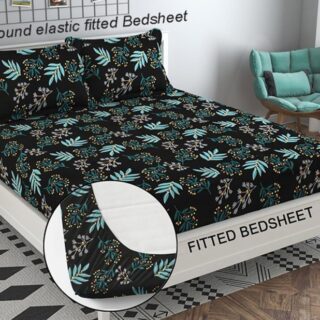 Home Garage 210 TC Cotton King Floral Fitted (Elastic) Bedsheet(Pack of 1, Fitted Black Green)
Home Garage 210 TC Cotton King Floral Fitted (Elastic) Bedsheet(Pack of 1, Fitted Black Green)
₹1,299.00Original price was: ₹1,299.00.₹299.00Current price is: ₹299.00. -
 Home Garage 180 TC Cotton King 3D Printed Flat Bedsheet(Pack of 1, White)
Home Garage 180 TC Cotton King 3D Printed Flat Bedsheet(Pack of 1, White)
₹999.00Original price was: ₹999.00.₹229.00Current price is: ₹229.00. -
 Home Sizzler 153 cm (5 ft) Polyester Room Darkening Window Curtain (Pack Of 2)(Floral, Maroon)
Home Sizzler 153 cm (5 ft) Polyester Room Darkening Window Curtain (Pack Of 2)(Floral, Maroon)
₹799.00Original price was: ₹799.00.₹299.00Current price is: ₹299.00. -
 Panipat Textile Hub 152.4 cm (5 ft) Polyester Window Curtain (Pack Of 2)(Solid, Aqua)
Panipat Textile Hub 152.4 cm (5 ft) Polyester Window Curtain (Pack Of 2)(Solid, Aqua)
₹1,899.00Original price was: ₹1,899.00.₹299.00Current price is: ₹299.00. -
 Home Sizzler 214 cm (7 ft) Polyester Semi Transparent Door Curtain (Pack Of 2)(Floral, Maroon)
Home Sizzler 214 cm (7 ft) Polyester Semi Transparent Door Curtain (Pack Of 2)(Floral, Maroon)
₹1,199.00Original price was: ₹1,199.00.₹399.00Current price is: ₹399.00. -
 Home Sizzler 153 cm (5 ft) Polyester Room Darkening Window Curtain (Pack Of 2)(Floral, Brown)
Home Sizzler 153 cm (5 ft) Polyester Room Darkening Window Curtain (Pack Of 2)(Floral, Brown)
₹799.00Original price was: ₹799.00.₹299.00Current price is: ₹299.00. -
 Stella Creations 214 cm (7 ft) Polyester Room Darkening Door Curtain (Pack Of 2)(Abstract, Brown)
Stella Creations 214 cm (7 ft) Polyester Room Darkening Door Curtain (Pack Of 2)(Abstract, Brown)
₹1,299.00Original price was: ₹1,299.00.₹449.00Current price is: ₹449.00. -
 Homefab India 152.5 cm (5 ft) Polyester Room Darkening Window Curtain (Pack Of 2)(Floral, Light Blue)
Homefab India 152.5 cm (5 ft) Polyester Room Darkening Window Curtain (Pack Of 2)(Floral, Light Blue)
₹1,199.00Original price was: ₹1,199.00.₹319.00Current price is: ₹319.00. -
 Urban Home 214 cm (7 ft) PVC Transparent Door Curtain Single Curtain(Solid, Off White)
Urban Home 214 cm (7 ft) PVC Transparent Door Curtain Single Curtain(Solid, Off White)
₹699.00Original price was: ₹699.00.₹203.00Current price is: ₹203.00. -
 Panipat Textile Hub 213 cm (7 ft) Polyester Door Curtain (Pack Of 2)(Solid, Brown)
Panipat Textile Hub 213 cm (7 ft) Polyester Door Curtain (Pack Of 2)(Solid, Brown)
₹1,199.00Original price was: ₹1,199.00.₹349.00Current price is: ₹349.00.
Affiliate Links
Promotion
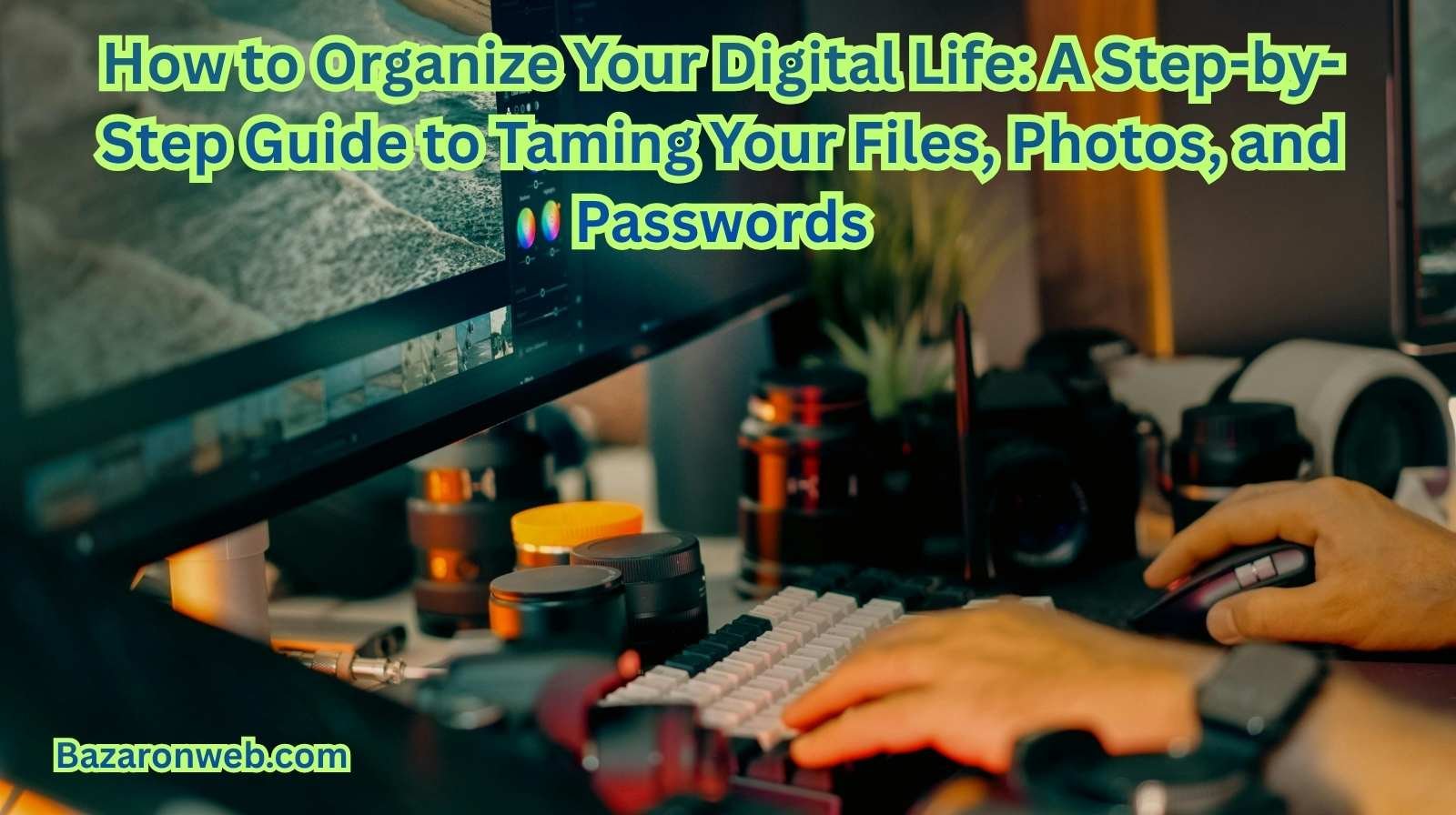
If you’ve ever wasted time searching for a lost file, scrolled endlessly to find one photo, or forgotten a password more times than you can count, you’re not alone. Our digital world is convenient, but it’s also chaotic. Between phones, laptops, cloud drives, email inboxes, social media accounts, and apps, it’s incredibly easy for clutter to pile up.
The good news? With the right system, you can bring order to the chaos and make your digital life feel lighter, faster, and more secure. In this guide, I’ll walk you through the best ways to organize your files, photos, passwords, and daily digital habits—so you spend less time searching and more time doing what you love.
Let’s declutter step by step.
1. Start With a Digital Declutter
Before you jump into organizing, begin by removing what you no longer need. Think of it like cleaning your room: organizing clutter is much harder than dealing with a clean space.
Do a full device sweep
Spend 20–30 minutes scanning through:
- Desktop files
- Downloads folder
- Documents folder
- Old screenshots
- Duplicate files
- Unused apps
- Large files consuming storage
Delete anything outdated, duplicate, or unnecessary. If you hesitate, ask yourself: “Will I ever use this again?” If the answer is no, remove it.
Uninstall apps you don’t use
Most people use less than 20% of the apps on their phone. Every unused app adds clutter, consumes storage, and runs hidden background processes.
Remove apps you haven’t opened in months unless they are essential.
2. Create a Folder Structure That Works for You
A messy file system is one of the biggest causes of digital frustration. The key is to create a structure that is:
- Simple
- Future-proof
- Easy to understand at a glance
Build 4–6 main folders
Here’s a structure that works for most people:
- Work
- Personal
- Finance
- Photos & Media
- School (if applicable)
- Home & Family
Inside each folder, add subfolders.
Example under Personal:
- Health
- Travel
- Certificates
- Projects
- Receipts
Avoid overly complicated nesting
Too many layers make things harder to find. Stick to a maximum of three levels deep.
Name files clearly
Use names that help you find documents quickly.
Good example:
- “Passport_Scan_2025”
- “Invoice_WebDesign_March2026”
- “TaxDocuments_2024”
Avoid vague names like:
- “scan1”
- “notes”
- “final_final_version”
3. Declutter and Organize Your Photo Library
Photos take up more space than almost anything else—and they’re usually the messiest part of our devices.
Step 1: Delete duplicates and junk
Remove:
- Screenshots
- Blurry images
- Accidental photos
- Images of receipts you already saved
- Multiple takes of the same moment
Step 2: Create Albums
Organize by:
- Year
- Event (e.g., wedding, birthday, trip)
- People
- Places
If you use Google Photos or iCloud, both offer automatic grouping and face detection to make this easier.
Step 3: Use cloud storage
Cloud services keep your photos safe even if your device is lost or damaged.
Recommended options:
- Google Photos
- iCloud Photos
- Amazon Photos (great if you’re a Prime member)
Step 4: Set up auto-backup
Enable automatic backup so every new photo syncs instantly. No more worrying about losing memories.
4. Manage Your Email Like a Pro
Most people’s inboxes are overflowing with old newsletters, receipts, promotions, and unread messages. You can fix this with a smart system.
Unsubscribe ruthlessly
If you don’t read emails from a sender at least once a week, unsubscribe.
Tools like Unroll.Me or Clean Email can help automate the process.
Use folders or labels
Create folders like:
- Work
- Bills & Receipts
- Travel
- Important
- Family
Enable filters
Filters sort emails automatically as they arrive.
Example:
- All receipts go to the “Bills” folder
- All work emails from your team go into “Work”
Archive instead of deleting
Archiving removes emails from your inbox without deleting them.
This keeps your inbox clean while preserving messages you may need later.
5. Your Passwords: Secure, Organized, and Easy
One of the most stressful parts of digital life is managing passwords. The safest and easiest solution is using a password manager.
Why you need a password manager
It allows you to:
- Generate strong, unique passwords
- Store passwords securely
- Autofill login details
- Sync across devices
- Avoid using the same password everywhere
Recommended options:
- 1Password
- Bitwarden (free option)
- Dashlane
- LastPass
Set up MFA for extra security
Enable multi-factor authentication (MFA) on:
- Banking apps
- Social media
- Cloud storage
- Payment apps
This extra layer protects your accounts even if your password leaks.
6. Organize Your Cloud Storage
Cloud drives often become a digital dumping ground. Treat them like an extension of your computer.
Clean up these cloud services:
- Google Drive
- OneDrive
- iCloud Drive
- Dropbox
Use matching folder structures
Keep folder names consistent across devices.
If your laptop has:
- Work
- Personal
- Finance
Your cloud drive should mirror that.
Move files, don’t duplicate them
Duplicate copies waste cloud storage and create confusion. Store files in one place and link or reference them if needed.
7. Keep Your Apps and Home Screens Minimal
A cluttered home screen creates mental noise. Decluttering your phone layout makes navigation faster and more enjoyable.
Organize apps into categories
Group apps like:
- Social
- Finance
- Utility
- Entertainment
- Work
- Health
Use app drawers or app library
Instead of trying to fit everything onto your home screen, hide rarely used apps in the app drawer or iOS App Library.
Put essential apps on the first page
Examples:
- Phone
- Messages
- Camera
- Maps
- Notes
- Calendar
8. Clean Up Your Browser
Your browser stores history, cookies, tabs, and extensions, which all add clutter.
Close old tabs
If you have 50–100 tabs open, your browser is running slower than it should.
Organize bookmarks
Create folders for:
- Shopping
- Work
- Research
- Inspiration
- Travel
Remove unnecessary browser extensions
Extensions can slow down your device and pose security risks.
9. Back Up Everything Regularly
Even the most organized digital life can fall apart if your data isn’t backed up.
The golden rule:
Use both cloud backup + local backup.
Use cloud backup
- iCloud Backup
- Google One
- OneDrive Backup
Use a physical backup
A simple external hard drive can back up:
- Photos
- Documents
- Projects
- Personal files
Set a reminder to back up monthly.
10. Create Weekly and Monthly Digital Habits
Digital organization lasts only if you maintain it. Build small habits so clutter never piles up again.
Weekly habits
- Clear downloads
- Delete unnecessary photos
- Review email inbox
- Update apps
- Check cloud storage
Monthly habits
- Back up devices
- Review passwords
- Reorganize files
- Remove unused apps
- Clean browser history and cache
Just 10–20 minutes a week keeps everything running smoothly.
11. Tools to Help You Stay Organized
Here are some powerful tools to make your digital life easier:
For file cleanup
- CCleaner
- CleanMyMac
- Files by Google
For photo organization
- Google Photos
- iCloud Photos
- Adobe Lightroom
For password management
- 1Password
- Bitwarden
- Dashlane
For email cleanup
- Clean Email
- Unroll.Me
12. Benefits of an Organized Digital Life
When your digital world is cleaned up, everything becomes easier:
- Faster device performance
- Less stress
- Easy access to files
- Safer accounts
- More storage space
- Improved productivity
- Better privacy
- A calmer, clutter-free mind
Digital organization isn’t just about your devices—it’s about improving your daily life.
Final Thoughts
Organizing your digital life isn’t a one-time job. It’s a habit. But once you set up the right system—clean folders, secure passwords, organized photos, minimal apps, and regular backups—you’ll feel the difference immediately.
Your phone will be faster. Your laptop will feel lighter. Your mind will feel clearer. And you’ll finally have control over your digital world instead of feeling overwhelmed by it.
You don’t need to do everything in one day. Start with one area—maybe your photos or your files—and build from there. In a week, you’ll be amazed at the transformation.
Written by Bazaronweb
Latest Tech Articles
- 5 Ways to Backup and Restore Registry Settings in Windows
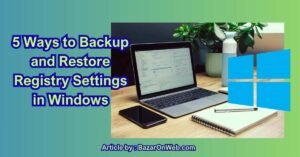
- iMessage Not Syncing Between iPhone & Mac? 8 Proven Ways to Fix Account & Device Issues

- Outlook Not Receiving Emails? 8 Proven Fixes for Windows, Mac & Mobile

- Zoom Not Connecting? 7 Ways to Fix Meeting Join Errors on Windows & Mac

- Microsoft Teams Not Opening? 5 Proven Fixes to Restart Your Workspace
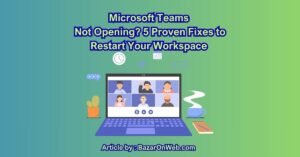
Products
-
![Apple Watch Ultra 3 [GPS + Cellular 49mm] Running & Multisport Smartwatch w/Rugged Titanium Case w/Black Titanium Milanese Loop - M. Satellite Communications, Advanced Health & Fitness Tracking](https://bazaronweb.com/retailstores/wp-content/uploads/2025/09/apple-watch-320x320.jpg) Apple Watch Ultra 3 [GPS + Cellular 49mm] Running & Multisport Smartwatch w/Rugged Titanium Case w/Black Titanium Milanese Loop - M. Satellite Communications, Advanced Health & Fitness Tracking
Apple Watch Ultra 3 [GPS + Cellular 49mm] Running & Multisport Smartwatch w/Rugged Titanium Case w/Black Titanium Milanese Loop - M. Satellite Communications, Advanced Health & Fitness Tracking
-
 Apple iPad mini (A17 Pro): Apple Intelligence, 8.3-inch Liquid Retina Display, 256GB, Wi-Fi 6E, 12MP Front/12MP Back Camera, Touch ID, All-Day Battery Life — Purple
Apple iPad mini (A17 Pro): Apple Intelligence, 8.3-inch Liquid Retina Display, 256GB, Wi-Fi 6E, 12MP Front/12MP Back Camera, Touch ID, All-Day Battery Life — Purple
-
 Apple AirPods Max Wireless Over-Ear Headphones, Active Noise Cancelling, Transparency Mode, Personalized Spatial Audio, Dolby Atmos, Bluetooth Headphones for iPhone – Space Gray
Apple AirPods Max Wireless Over-Ear Headphones, Active Noise Cancelling, Transparency Mode, Personalized Spatial Audio, Dolby Atmos, Bluetooth Headphones for iPhone – Space Gray
-
 Apple AirPods Pro 2 Wireless Earbuds, Active Noise Cancellation, Hearing Aid Feature, Bluetooth Headphones, Transparency, Personalized Spatial Audio, High-Fidelity Sound, H2 Chip, USB-C Charging
Apple AirPods Pro 2 Wireless Earbuds, Active Noise Cancellation, Hearing Aid Feature, Bluetooth Headphones, Transparency, Personalized Spatial Audio, High-Fidelity Sound, H2 Chip, USB-C Charging
-
 Leo Creation 144 TC Cotton Double Jaipuri Prints Flat Bedsheet(Pack of 1, Blue, Gree, Red, Grey, Light Grey)
Leo Creation 144 TC Cotton Double Jaipuri Prints Flat Bedsheet(Pack of 1, Blue, Gree, Red, Grey, Light Grey)
₹2,999.00Original price was: ₹2,999.00.₹329.00Current price is: ₹329.00.
Leave a Reply